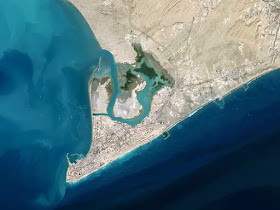Iran’s parliament has voted to close the Strait of Hormuz, the vital shipping channel through which around 20% of the world’s daily oil flows.
The move, which could block $1 billion in oil shipments per day, is likely to send oil prices soaring.
Brent crude oil, the international standard, jumped 3.9% to $80 a barrel on Sunday, while US crude rose 4.3% to $77 a barrel.
The conflict between Israel and Iran has sent oil prices yo-yoing over the past week, which has in turn caused see-saw moves for the U.S. stock market, because of rising and ebbing fears that the war could disrupt the global flow of crude. Iran is a major producer of oil and also sits on the narrow Strait of Hormuz, through which much of the world’s crude passes.
It will come into effect pending a final decision by Iran’s Supreme Council.
The Supreme Council’s decision must be made by tonight, according to Iran’s state-run Press TV.
Iran’s major escalation in response to US strikes on its nuclear facilities “will be done whenever necessary,” Email Kosari, Commander in the Revolutionary Guards, said on Sunday.
The strait connecting the Gulf of Oman with the Persian Gulf is one of the world’s most critical chokepoints — just 20 miles wide at its narrowest point.
Shipping lanes in the strait — the area that is deep enough for ships to pass — are even narrower at less than two miles wide in each direction, making them much more vulnerable to attacks and threats of closure.
The channel is shallow, making it a particular target for underwater mining, while the narrowness of the strait makes passing vessels vulnerable to attack from shore-based missiles or interception by patrol boats or helicopters.
“Iran would most likely pursue a multi-layered asymmetric strategy rather than attempting an outright naval blockade,” Gregg Roman, Executive Director of the Middle East Forum told The Post.
“Their primary approach would involve rapidly deploying naval mines across the shipping lanes—this is their most effective tool for immediate disruption. They’d simultaneously launch anti-ship missiles from mobile coastal batteries like their Ghader and Nasir systems, targeting oil tankers from distances up to [185 miles].”
Iran has no legal authority to block sea traffic through Hormuz, and any attempts by its navy to bar entry to the strait would likely be met by a strong response.
Ships with the US Fifth Fleet, along with other Western navies, are patrolling the area at all times.
It is bordered by Iran to the north and Oman and the United Arab Emirates to the south.
The bulk of all oil exported by the regional petro giants, Iran, Iraq, Kuwait, Qatar, Saudi Arabia and the UAE, all travel through this narrow waterway.
Asia is likely to bear the brunt most from any closures to the waterway, with China, India, Japan and South Korea all getting most of their oil imports through the strait.
China, the world’s biggest buyer of Iranian oil and a critical partner that has previously used its veto power at the UN Security Council to block sanctions or resolutions against Tehran, would be particularly affected by any closure.
The move would also hit Iran’s own economy.
“Any closure attempt would be temporary and ultimately self-destructive. Iran depends on the strait for its own vital imports and knows that such action would trigger an overwhelming response from the US 5th Fleet, which maintains detailed operational plans for exactly this scenario,” Roman said.
“It would amount to economic suicide while alienating China, their primary oil customer. Tehran understands this calculus, which is why the threat remains more valuable as leverage than as an actual course of action.”
Iran last disrupted traffic in the Persian Gulf in April last year when it seized an Israel-linked container ship near the Strait of Hormuz, accusing the MSC Aries of violating maritime regulations.
In April 2023, Iran seized a US-bound tanker, claiming the ship had struck another vessel.
And in May 2022, two Greek tankers were held for six months in what was widely seen as retaliation to the confiscation of Iranian oil on a different ship by Greek and US authorities.
In previous years, the Houthi militia in Yemen was able to successfully disrupt traffic through the Bab el-Mandeb Strait leading into the Red Sea on the other side of the Arabian Peninsula.
Using the firing of missiles and drones, the Houthis were able to cut ship traffic through the Red Sea and the Gulf of Aden some 70% in June compared with the average levels in 2022 and 2023, according to Clarkson Research Services Ltd, a unit of the world’s largest shipbroker.
Vessel operators have been forced instead to reroute traffic around the southern tip of Africa instead of using the Suez Canal, making journeys for ships traveling between Europe and Asia vastly more expensive and much longer.
Iran’s Navy was likely to employ the same tactics previously used by the Houthis, along with cyber attacks and other sabotage operations, Roman added.
“The IRGC Navy would execute their proven ‘swarm’ tactics, using hundreds of small, fast boats armed with missiles and explosives to overwhelm defenses,” he said. “We’d also see extensive use of suicide drones and explosive-laden unmanned boats, tactics they’ve perfected through their Houthi proxies in the Red Sea.
“Iran would likely pursue several additional avenues: cyber attacks on port infrastructure and shipping navigation systems, activation of regional proxies to create multiple crisis points and stretch U.S. forces, sabotage operations against Saudi and UAE oil facilities, and potentially targeting Gulf states’ desalination plants to pressure them against supporting American operations,” he added.

Another opportunity for the US to hit Iran from its base in Qatar (oh, the irony)
ReplyDelete